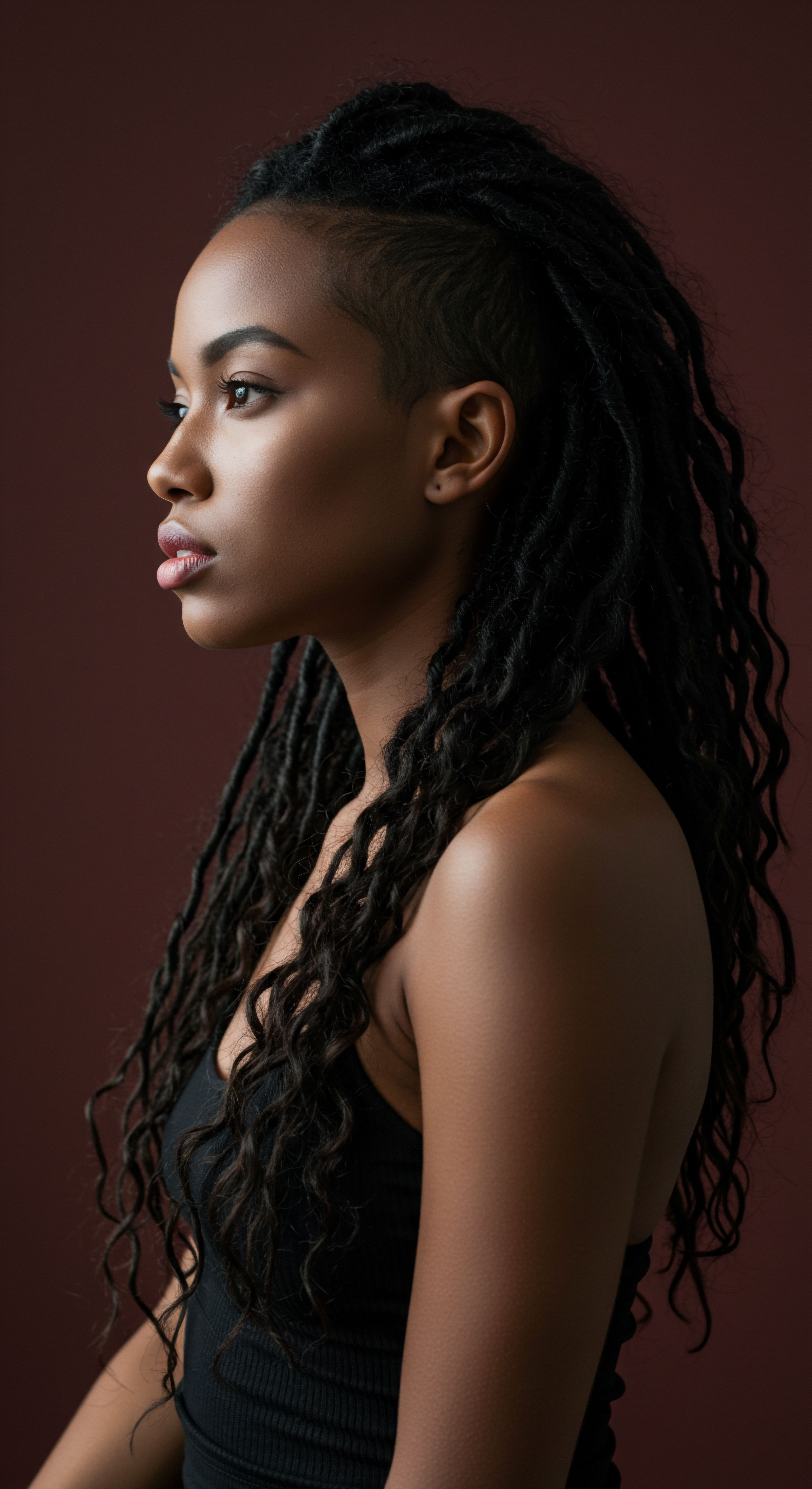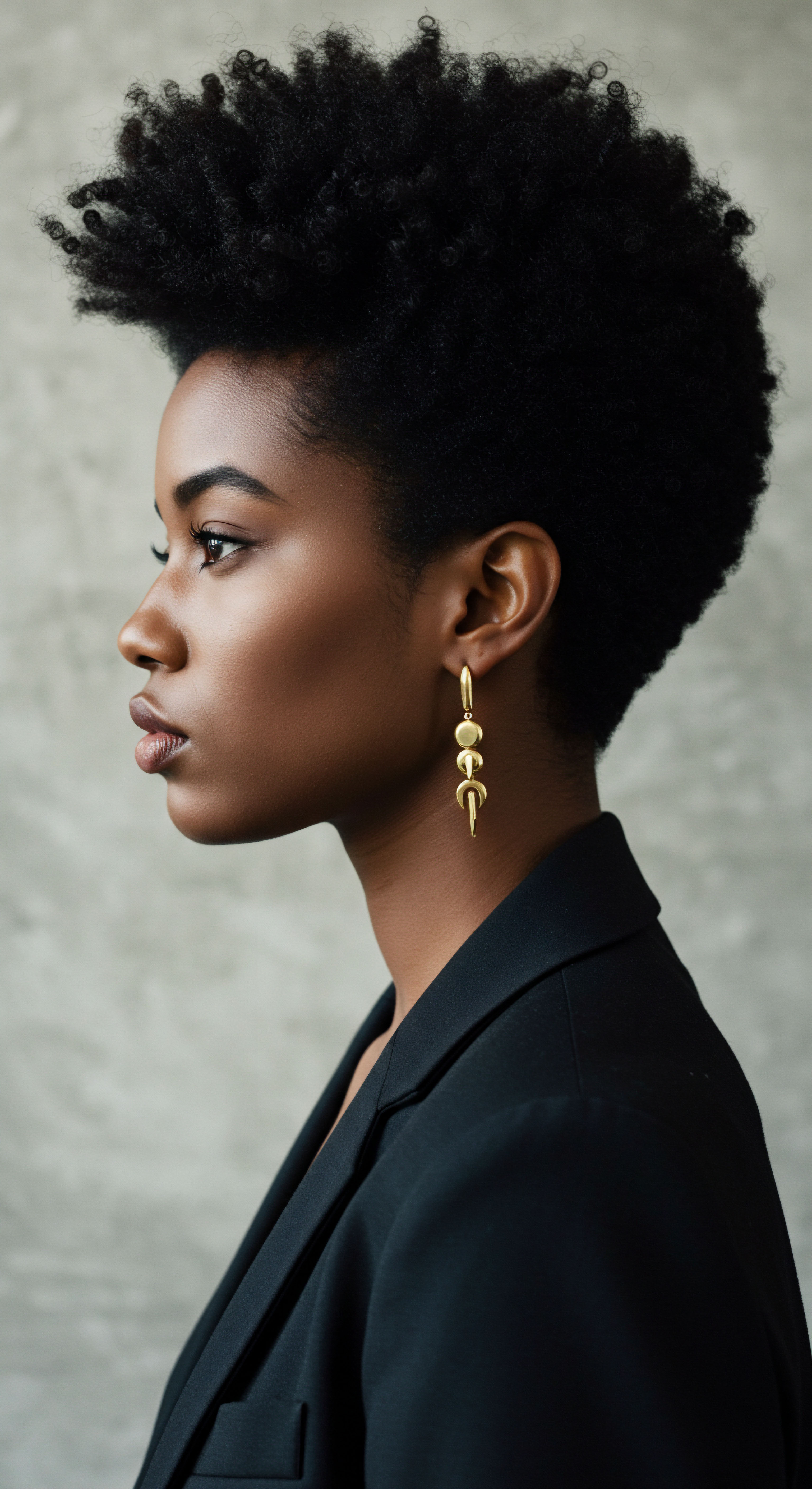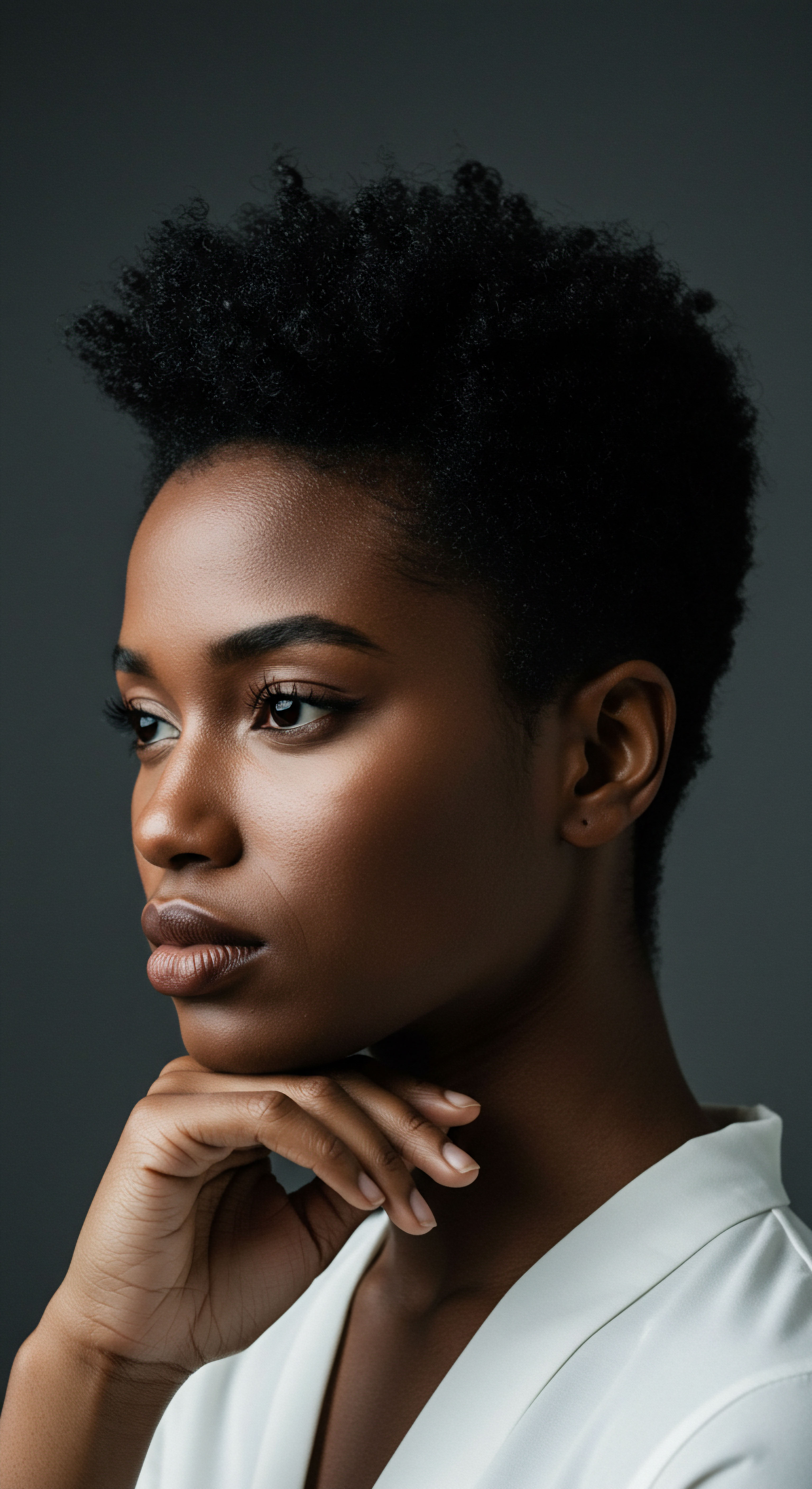
Roots
The whisper of night, the gentle cadence of slumber, often feels like a retreat from the world’s demands. Yet, beneath the surface of this quiet repose, a profound dance of renewal unfolds within our bodies. For those who nurture textured hair, a curious question often surfaces ❉ could the consistency of our sleep truly hold sway over the fullness and vibrancy of our strands?
This inquiry invites us to consider hair not merely as an external adornment, but as a living testament to our inner equilibrium. To understand this connection, we begin at the cellular heart of hair itself, delving into the biological rhythms that orchestrate its presence.

Hair Anatomy and Physiology Specific to Textured Hair
Each strand of textured hair, whether a coil, a curl, or a wave, springs from a tiny organ beneath the scalp ❉ the Hair Follicle. These follicles are not static structures; they are dynamic mini-organs, deeply rooted in the dermal layer of the skin. The shape of the follicle itself, rather than the hair shaft, largely determines the curl pattern of textured hair.
A more elliptical or oval follicle shape results in tighter curls, while a rounder follicle produces straighter strands. This anatomical distinction means that the processes supporting hair growth and density in textured hair types must account for the unique architecture of the follicle and the mechanical stresses inherent in its coiled structure.
Within the follicle, specialized cells known as Dermal Papilla Cells play a critical role, sending signals that regulate the growth and cycling of hair. These cells are highly sensitive to systemic changes within the body, including hormonal shifts and nutrient availability. The health of the follicle, therefore, directly influences the strength, thickness, and ultimately, the density of the hair that emerges.

Hair Growth Cycles and Influencing Factors
Hair growth follows a cyclical pattern, a biological rhythm that repeats throughout our lives. This cycle has three primary phases:
- Anagen ❉ The active growth phase, where hair cells rapidly divide and hair lengthens. This phase can last from two to seven years.
- Catagen ❉ A brief transitional phase, lasting a few weeks, where hair growth slows and the follicle shrinks.
- Telogen ❉ The resting phase, which lasts a few months. During this period, the hair remains in the follicle but is not actively growing, eventually shedding to make way for new growth.
The balance and duration of these phases dictate hair density. When more hair follicles are in the anagen phase, and for longer periods, hair appears fuller. Conversely, a premature shift into the catagen or telogen phase, or a prolonged telogen phase, can lead to noticeable thinning or loss.
Numerous internal and external factors can influence this delicate cycle, from nutrition and genetics to environmental stressors and, indeed, our sleep patterns. A well-functioning cycle depends on the body’s systems operating in concert, and sleep is a profound conductor of this biological orchestra.
The intricate dance of hair growth is a delicate balance, with each strand’s vitality tied to the hidden rhythms within our bodies.

Ritual
The rhythm of our days often feels like a constant push, a succession of tasks and engagements. Yet, as the sun dips below the horizon, there is an invitation to shift gears, to welcome the quietude that allows for internal restoration. For textured hair, the nighttime hours are already a time of intentional care, a ritual of protection against the friction of movement and the dryness of the air.
But what if this nightly practice could extend beyond the physical, reaching into the very biological processes that sustain hair density? Our understanding of sleep as a practical tool for hair wellness prompts us to consider the unseen work our bodies perform when we rest.

The Nighttime Sanctuary ❉ Essential Sleep Protection and Bonnet Wisdom
For individuals with textured hair, nighttime care is a cornerstone of maintaining length and strength. The deliberate act of preparing hair for sleep minimizes mechanical damage. Silk or satin bonnets, scarves, and pillowcases serve as a gentle shield, reducing friction that can lead to breakage, tangles, and frizz. This protective layer helps retain moisture, which is vital for the elasticity and overall health of textured strands.
Consider the simple act of wrapping your hair before bed. This is not merely a styling choice; it is a profound gesture of care, a recognition of the hair’s vulnerability during unconscious movement. This physical protection lays a groundwork, allowing the deeper biological processes that occur during sleep to proceed unimpeded. The integrity of the hair shaft is preserved, ensuring that the new growth supported by quality sleep has a strong foundation upon which to flourish.

How Does Sleep Quality Influence Hair Follicle Activity?
Beyond the physical safeguarding, the quality of our sleep holds sway over the very environment within the hair follicle. During deep sleep stages, the body enters a mode of repair and regeneration. This is when vital hormones, including those that play a part in hair growth, are released. Adequate sleep supports balanced levels of these hormones, which in turn influence the hair cycle.
When sleep is consistently disrupted, the body’s internal clock, known as the Circadian Rhythm, can fall out of sync. This disruption can have consequences for the hair growth cycle. Hair follicles, like other tissues, follow this biological clock. A lack of sufficient, restorative sleep can push hair follicles prematurely into the resting phase, leading to increased shedding and a noticeable reduction in perceived density.
Nighttime rituals extend beyond physical care, influencing the very biological environment that sustains hair health.
Here is a closer look at how sleep quality impacts hair follicle activity:
- Hormonal Regulation ❉ During deep sleep, the body releases growth hormone, a key factor in cell regeneration, including the regeneration of hair follicles. Melatonin, a hormone known for regulating sleep-wake cycles, also serves as a powerful antioxidant that protects hair cells. Disrupted sleep can hinder the optimal production and regulation of these hormones, thereby impacting hair growth.
- Blood Circulation ❉ While we sleep, blood flow to the scalp improves, delivering oxygen and vital nutrients to the hair follicles. This nourishment is essential for healthy hair. Insufficient sleep can impair this circulation, depriving follicles of the resources they need to function optimally, potentially leading to weaker hair and slower growth.
- Cellular Repair ❉ The body’s cellular repair mechanisms are most active during sleep. Hair follicles undergo repair and regeneration, preparing for the next growth cycle. When sleep is compromised, these repair processes are less efficient, which can affect the overall vitality and density of the hair over time.

What are the Signs of Sleep-Related Hair Concerns?
Observing changes in your hair can sometimes offer clues about your sleep patterns. While hair thinning or increased shedding can arise from many sources, a consistent pattern of insufficient or restless sleep might contribute. Look for:
- Increased Shedding ❉ More hair than usual on your pillow, in your comb, or in the shower drain could indicate a shift in the hair growth cycle.
- Reduced Density ❉ A general feeling that your hair is not as full as it once was, or that your scalp is more visible.
- Dullness or Lack of Luster ❉ Hair that appears less vibrant or healthy, which can be a sign of compromised nutrient delivery or cellular repair.
These observations are not definitive diagnoses, but they serve as gentle prompts to consider the broader context of your well-being, including your sleep habits. Addressing sleep concerns can be a supportive step in promoting overall hair health.

Relay
As we move beyond the immediate surface of hair care and the rhythms of daily ritual, a deeper current reveals itself ❉ the profound, intricate interplay between our inner biological clock and the visible health of our hair. Can the consistent pursuit of restorative sleep truly influence the density of our hair, or is this a mere wish, a hopeful connection? This section delves into the scientific underpinnings, drawing upon research that illuminates the subtle yet powerful mechanisms at play, sometimes challenging conventional thought about hair health.

The Hormonal Orchestration of Hair Growth
Our sleep-wake cycle, or circadian rhythm, is a finely tuned system, profoundly influencing hormonal secretion. Two key hormones, cortisol and melatonin, stand at the forefront of this biological concert, each playing a distinct role in hair follicle health. Cortisol, often termed the “stress hormone,” typically peaks in the morning and declines at night. However, chronic sleep deprivation or sustained psychological strain can disrupt this natural pattern, leading to elevated cortisol levels, even during the night.
Elevated cortisol can have a detrimental effect on hair follicles. Research indicates that high cortisol levels can accelerate the degradation of vital skin elements, such as hyaluronan and proteoglycans, by approximately 40%. These elements are essential for the proper functioning and cyclic regulation of the hair follicle. When these substances are compromised, the hair follicle’s delicate environment is disturbed, potentially pushing hair into a premature resting phase and contributing to conditions like telogen effluvium, a temporary hair loss characterized by increased shedding.
A study from Harvard University researchers, for instance, identified a biological mechanism in mice where a major stress hormone (corticosterone, equivalent to human cortisol) put hair follicle stem cells into an extended resting phase, preventing the regeneration of the follicle and hair. They discovered that this hormone acted on dermal papilla cells, preventing them from secreting GAS6, a molecule capable of activating hair follicle stem cells. Delivering GAS6 into the skin restored hair growth in mice under chronic stress. This points to a tangible, molecular pathway linking stress, sleep disruption, and hair growth.
Conversely, melatonin, primarily produced in darkness, is not only a sleep inducer but also possesses antioxidant properties and may directly stimulate hair growth. Studies suggest that melatonin can prolong the anagen (growth) phase of the hair cycle and protect follicles from oxidative stress. A systematic review encompassing 11 human studies found that topical application of melatonin improved scalp hair growth, density, and hair shaft thickness among users with androgenetic alopecia compared to controls. While this research often pertains to topical application, it underscores melatonin’s direct role in hair biology, linking its natural production during quality sleep to potential benefits for hair density.

Can Sleep Quality Directly Influence Hair Follicle Stem Cells?
The concept of stem cells within hair follicles is not new, yet their responsiveness to sleep quality presents a compelling area of study. Hair follicle stem cells are responsible for the continuous regeneration of hair throughout our lives. These cells are highly sensitive to their microenvironment and the systemic signals they receive.
Disruptions to the circadian rhythm, which is inextricably linked to sleep-wake cycles, have been shown to affect the progression of the hair cycle. Research indicates that circadian clock genes are expressed in hair follicles and play a role in regulating the hair cycle. For example, studies on mice with mutations to central clock genes (Clock and Bmal1) showed a significant delay in the progression of the hair growth phase. These clock genes affect the expression of key cell cycle control genes, suggesting that the circadian clock modulates hair growth by influencing cell cycle progression within the hair follicle.
The silent hours of slumber hold the key to unlocking the body’s regenerative potential for hair.
This deeper understanding moves beyond simply managing stress. It suggests that the very timing and quality of our sleep can directly impact the regenerative capacity of the hair follicle stem cells, potentially leading to more robust and consistent hair growth over time.

The Unseen Hand of Inflammation and Sleep
Beyond hormones and stem cells, sleep exerts its influence through the body’s inflammatory response. Chronic sleep deprivation can lead to elevated levels of pro-inflammatory cytokines, which are signaling molecules that indicate inflammation. This systemic inflammation can negatively impact various bodily functions, including the health of hair follicles.
Inflammation around hair follicles can hinder their ability to function properly, potentially leading to hair loss conditions. For instance, increased levels of pro-inflammatory cytokines can signal hair to shed prematurely. While often temporary, such shedding can contribute to a noticeable reduction in hair density. The link between sleep deprivation and increased inflammatory markers is well-documented, with studies showing associations between sleep disturbance and higher levels of C-reactive protein (CRP) and interleukin-6 (IL-6).
A less commonly discussed aspect, though not directly controversial, is the relationship between sleep disorders like sleep apnea and hair health. Sleep apnea, characterized by repeated interruptions in breathing during sleep, can cause disruptions in oxygen blood levels. These disruptions can lead to a state of chronic stress and inflammation within the body, potentially contributing to inflammatory hair loss. This connection underscores that addressing underlying sleep disorders can be a critical, albeit sometimes overlooked, step in managing hair density concerns.
To synthesize these intricate connections, consider the following table outlining the key physiological impacts:
| Physiological Aspect Hormone Balance |
| Impact of Consistent Sleep Supports optimal levels of growth hormone and melatonin, regulating hair cycles. |
| Consequence of Poor Sleep Elevates cortisol, potentially shortening the anagen phase and increasing shedding. |
| Physiological Aspect Cellular Regeneration |
| Impact of Consistent Sleep Promotes active repair and renewal of hair follicle stem cells. |
| Consequence of Poor Sleep Impairs stem cell activity, leading to slower regeneration and thinner hair. |
| Physiological Aspect Blood Circulation |
| Impact of Consistent Sleep Ensures steady delivery of oxygen and nutrients to the scalp and follicles. |
| Consequence of Poor Sleep Reduces blood flow, depriving follicles of vital sustenance. |
| Physiological Aspect Inflammatory Response |
| Impact of Consistent Sleep Maintains lower levels of systemic inflammation. |
| Consequence of Poor Sleep Increases pro-inflammatory cytokines, potentially triggering premature shedding. |
| Physiological Aspect Consistent, quality sleep underpins the body's natural processes that support healthy hair density. |
The evidence points to a resounding affirmation ❉ consistent, quality sleep does indeed hold significant sway over hair density, not through a singular, direct action, but through a complex, interconnected web of hormonal regulation, cellular repair, and inflammatory control. It is a quiet, powerful contributor to the vibrant health of our textured strands.

Reflection
As we conclude this exploration into the profound connection between consistent sleep and hair density, a larger understanding unfolds. Our hair, particularly textured hair with its unique requirements, is not merely a surface adornment; it is a sensitive barometer of our internal state, a living testament to the delicate balance within. The pursuit of dense, vibrant strands then becomes less about external fixes and more about cultivating a deeper harmony within our being.
It beckons us to honor the body’s innate wisdom, to respect the quiet hours of restoration, and to recognize that true radiance often begins in the gentle stillness of night. This perspective invites us to reconsider our daily choices, seeing each moment of rest as a quiet investment in the health and beauty that springs from within.

References
- Centre Clauderer. Hair and sleep ❉ the importance of the night for hair health.
- HHC Clinics. Sleep and Hair Growth – What’s the Connection?
- Treatment Rooms London. Can A Lack of Sleep Cause Hair Loss?
- Hair Doctors. Can Lack of Sleep Make You Lose Hair? Uncovering the Connection.
- HairFree & HairGrow. Sleep and Hair Loss. Relationship Explained.
- Babadjouni, A. Reddy, K. & Zhang, A. (2023). Melatonin and the Human Hair Follicle. Journal of Drugs in Dermatology, 22(3).
- Clinikally. Impact of Sleep Deprivation on Hair Health.
- Dr Nagwani. Sleep and Hair Growth ❉ What’s the Connection?
- ResearchGate. Melatonin and the Human Hair Follicle.
- Does Sleep Affect Hair Loss? The Science Explained.
- Corti Hormonal Research. Melatonin ❉ A Game-Changer for Hair Growth and Health – In-Depth Analysis.
- Limmer Hair Transplant Center. Can Lack of Sleep Cause Hair Loss?
- I Am Designed to Heal. Unlock Better Sleep and Reduce Anxiety with Scalp Acupuncture.
- HCPLive. Hair, Scalp Health Linked to Perceived Stress and Sleep Quality.
- Healthline. Does Melatonin Cause Hair Loss? What Research Shows.
- PubMed. Melatonin and the Human Hair Follicle.
- Typology. The consequences of a lack of sleep on your hair.
- Cho, S. & Sung, H. (2009). Circadian Clock Genes Contribute to the Regulation of Hair Follicle Cycling. PLoS Genetics, 5(7).
- Harvard Gazette. Researchers discover how chronic stress leads to hair loss.
- Dermatology Times. Newly Developed Questionnaire Evaluates Quality of Life for Patients with Hair and Scalp Conditions.
- Saatva. Can Lack of Sleep Cause Hair Loss?
- Thom, E. (2016). Stress and the Hair Growth Cycle ❉ Cortisol-Induced Hair Growth Disruption. Journal of Drugs in Dermatology, 15(8), 1001-1004.
- Oxford Academic. Sleep Deprivation and Recovery Sleep Prior to a Noxious Inflammatory Insult Influence Characteristics and Duration of Pain.
- National Institutes of Health (NIH). How stress causes hair loss.
- Vegamour. Inflammatory Cytokines & Hair Loss ❉ What You Should Know.
- ResearchGate. Effect of scalp point penetration needling on sleep quality and sleep structure of insomnia patients.
- DiStefano Hair Restoration Center. Does Sleep Affect Hair Health?
- MDPI. Hair Follicles as a Critical Model for Monitoring the Circadian Clock.
- ResearchGate. CLOCK–regulated genes are periodically expressed during hair follicle.
- PNWS-AWWA. The effect of sleep quality on hair regrowth.
- ResearchGate. (PDF) Stress and the Hair Growth Cycle ❉ Cortisol-Induced Hair Growth Disruption.
- PubMed. Stress and the Hair Growth Cycle ❉ Cortisol-Induced Hair Growth Disruption.
- MDPI. Overview of the Circadian Clock in the Hair Follicle Cycle.
- MDPI. Systems Biology Approaches and Precision Oral Health ❉ A Circadian Clock Perspective.
- Frontiers. The relationship between sleep and salivary and serum inflammatory biomarkers in adolescents.
- MDPI. Hair Cortisol Concentration as a Biomarker of Sleep Quality and Related Disorders.
- MDPI. The Impact of Sleep Quality on Mood Status and Quality of Life in Patients with Alopecia Areata ❉ A Comparative Study.